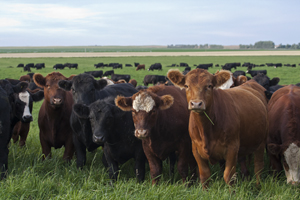Have You Rotated Your Breeds Lately?
This article written by Dr. Reynold Bergen, BCRC Science Director, originally appeared in the May 2018 issue of Canadian Cattlemen magazine and is reprinted on the BCRC Blog with permission of the publisher.

Before becoming a politician and long before becoming a noted Western Canadian historian, Grant McEwan was an animal science professor at the University of Saskatchewan. In 1938, he and A.M. Shaw published “An Experiment in Beef Production in Western Canada” (Scientific Agriculture XIX:177-198), summarizing one of Canada’s first crossbreeding projects. Straightbred 2-year old Angus, Shorthorn, Galloway and Hereford cows (40 each) were pastured year-round on the Matador community pasture in southwestern Saskatchewan and bred to Angus (1930), Hereford (1931), Shorthorn (1932) and Galloway bulls (1933). As a result, each calf crop had 25% straightbred and 75% F1 crossbred calves. The calves were finished for slaughter at the university feedlot in Saskatoon. Crossbred calves averaged 3% higher weaning weights, average daily gain and finished weights than the straightbreds, and 18% more crossbred calves fell into the top carcass grade compared to the straightbreds. This superiority of crossbreds relative to their straightbred parents came to be known as hybrid vigor (heterosis). Hybrid vigor happens because crossbreeding overcomes the inbreeding depression that occurs in purebred or straightbred populations.
Family members are genetically more similar than unrelated animals. When relatives are mated, their offspring will be even more genetically uniform. This can bring disadvantages, like genetic defects carried by recessive genes. When an offspring inherits a dominant normal form of a gene from one parent and a recessive defective form of the gene from the other parent, the dominant normal gene will mask the recessive defective gene and the offspring will appear normal. But if the offspring inherits recessive defective versions of the gene from both parents, the offspring will express the genetic defect. This happened in the 1950’s, when a showring fad for “belt buckle” height cattle led to intensive line-breeding and single trait selection that ultimately produced dwarf cattle. That is a severe example of inbreeding depression.
All purebred or straightbred cattle are impacted by inbreeding depression to some degree. Cattle of the same breed all belong to the same family tree. Cattle from distant branches of the pedigree are less related than those from nearby branches, but they are still related to some extent. Purebred cattle have advantages in terms of identifying and selecting superior genetics, but in commercial situations, crossbreeding combines superior genetics from different breeds and eliminates the inbreeding depression at the same time.
Hybrid vigor generally provides the most benefits to fertility, reproduction, and other low-heritability traits that are difficult to improve by genetic selection and is greatest when vastly different breeds are mated. In 1950, Agriculture Canada researchers imported three Brahman bulls from California, mated them to Hereford cows at the Onefour research station in southeastern Alberta, and compared the lifetime productivity of 22 Brahman x Hereford F1 females to 26 straightbred Hereford females (“Brahman-British Beef Cattle Crosses in Canada I. Weaned Calf Production Under Range Conditions”; Canadian Journal of Animal Science 47:145-151). Sixteen years later, all but 5 of the 26 straightbreds had been culled for failing to wean a calf in two consecutive years, for cancer eye, or udder structure. In contrast, 13 of the original 22 crossbreds were still in the herd (4 had been culled for being open, and 5 winterkilled).
Hybrid vigor is maximized (100%) in the first cross (F1); it will be maintained at that level if the F1 is crossed to a third breed. But if the F1 cross is bred back to one of the parental breeds, 50% of the hybrid vigor will be lost in the F2. If the same breed of bull is always used to produce future replacements, only 3% hybrid vigor would remain in the F6 generation. That’s not surprising; the average F6 is 98.5% pure – it’s effectively not a crossbred anymore.
Crossbreeding might be less common now in Canada than it used to be. In 1995, no single breed accounted for more than a quarter of Canadian purebred registrations. In 2015, Angus accounted for over half of all Canadian purebred registrations. This has been driven by the quality of Angus cattle and the popularity of the Certified Angus Beef marketing program. The Angus influence may be even more widespread, judging by the appearance of black cattle in breeds that were traditionally yellow or red.
A report from a project led by Dr. John Basarab of Alberta Agriculture and Forestry (“Genomic retained heterosis effects on fertility and lifetime productivity in beef heifers”) will be published in an upcoming edition of the Canadian Journal of Animal Science. This project used DNA tests for breed composition, which are highly correlated with breed composition estimated from breeding records. Among other findings, this study found that cows with higher genetic diversity (roughly F1 or F2) averaged $161 greater net annual returns than less genetically diverse cows (e.g. F3 or greater) due to $74 higher income per weaned calf and $88 per head lower replacement costs.
Hybrid vigor is an opportunity for commercial producers to affordably improve cow fertility, longevity, lifetime productivity and production economics.
Click here to subscribe to the BCRC Blog and receive email notifications when new content is posted.
The sharing or reprinting of BCRC Blog articles is typically welcome and encouraged, however this article requires permission of the original publisher.
We welcome your questions, comments and suggestions. Contact us directly or generate public discussion by posting your thoughts below.